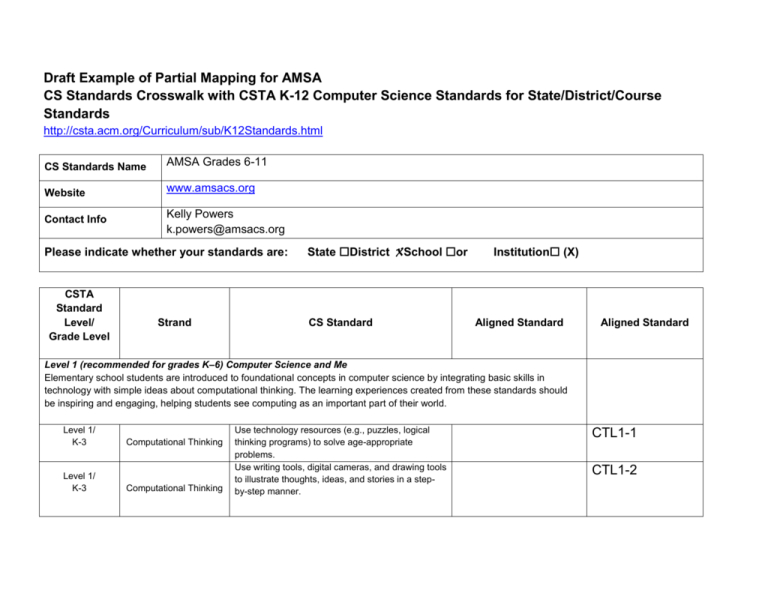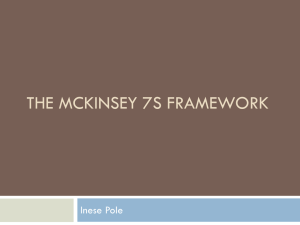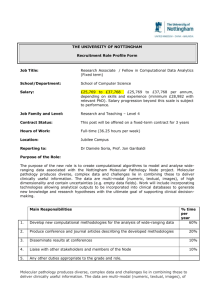Draft Example of Partial Mapping for AMSA
advertisement

Draft Example of Partial Mapping for AMSA CS Standards Crosswalk with CSTA K-12 Computer Science Standards for State/District/Course Standards http://csta.acm.org/Curriculum/sub/K12Standards.html CS Standards Name AMSA Grades 6-11 Website www.amsacs.org Contact Info Kelly Powers k.powers@amsacs.org Please indicate whether your standards are: CSTA Standard Level/ Grade Level Strand State District XSchool or CS Standard Institution (X) Aligned Standard Aligned Standard Level 1 (recommended for grades K–6) Computer Science and Me Elementary school students are introduced to foundational concepts in computer science by integrating basic skills in technology with simple ideas about computational thinking. The learning experiences created from these standards should be inspiring and engaging, helping students see computing as an important part of their world. Level 1/ K-3 Level 1/ K-3 Computational Thinking Computational Thinking Use technology resources (e.g., puzzles, logical thinking programs) to solve age-appropriate problems. Use writing tools, digital cameras, and drawing tools to illustrate thoughts, ideas, and stories in a stepby-step manner. CTL1-1 CTL1-2 CSTA Standard Level/ Grade Level Strand CS Standard Aligned Standard Aligned Standard Level 1 (recommended for grades K–6) Computer Science and Me Elementary school students are introduced to foundational concepts in computer science by integrating basic skills in technology with simple ideas about computational thinking. The learning experiences created from these standards should be inspiring and engaging, helping students see computing as an important part of their world. Level 1/ K-3 Computational Thinking Level 1/ K-3 Computational Thinking Level 1/ K-3 Level 1/ 3-6 Level 1/ 3-6 Computational Thinking Computational Thinking Computational Thinking Level 1/ 3-6 Computational Thinking Level 1/ Computational Thinking Understand how to arrange (sort) information into useful order, such as sorting students by birth date, without using a computer. CTL1-3 Recognize that software is created to control computer operations. CTL1-4 Demonstrate how 0s and 1s can be used to represent information. Understand and use the basic steps in algorithmic problem-solving (e.g., problem statement and exploration, examination of sample instances, design, implementation, and testing). CTL1-5 Notion of algorithms Grade 6, Topic 13, Designing Solutions, Pseudo Code, Flowchart, Coding Algorithms CTL1-6 Develop a simple understanding of an algorithm (e.g., search, sequence of events, or sorting) using computer-free exercises. Notion of algorithms Grade 6, Topic 13, Designing Solutions, Pseudo Code, Flowchart, Coding Algorithms CTL1-7 Demonstrate how a string of bits can be used to represent alphanumeric information. CTL1-8 Describe how a simulation can be used to solve a Coding letters with numbers ASCII and Unicode with binary & hex, RGB in HEX Grade 6, Topic 12, How Computers Think CTL1-9 CSTA Standard Level/ Grade Level Strand CS Standard Aligned Standard Aligned Standard Level 1 (recommended for grades K–6) Computer Science and Me Elementary school students are introduced to foundational concepts in computer science by integrating basic skills in technology with simple ideas about computational thinking. The learning experiences created from these standards should be inspiring and engaging, helping students see computing as an important part of their world. 3-6 Level 1/ 3-6 Level 1/ 3-6 Level 1/ K-3 Level 1/ K-3 problem. Make a list of sub-problems to consider while addressing a larger problem. Creating a Strategy, writing steps to solve a problem Notion of algorithms Grade 6, Topic 13, Designing Solutions, Pseudo Code, Flowchart, Coding Algorithms CTL1-10 Understand the connections between computer science and other fields. CTL1-11 Computational Thinking Computational Thinking Collaboration Collaboration Babbage (analytic engine), Von Neumann, Harvard Mark I, analog computers. Grade 6, Unit 1: Topic 1History of Computers and Computation Gather information and communicate electronically with others with support from teachers, family members, or student partners. COL1-1 Work cooperatively and collaboratively with peers, teachers, and others using technology. COL1-2 CSTA Standard Level/ Grade Level Strand CS Standard Aligned Standard Aligned Standard Level 1 (recommended for grades K–6) Computer Science and Me Elementary school students are introduced to foundational concepts in computer science by integrating basic skills in technology with simple ideas about computational thinking. The learning experiences created from these standards should be inspiring and engaging, helping students see computing as an important part of their world. Level 1/ 3-6 Level 1/ 3-6 Level 1/ 3-6 Level 1/ K-3 Level 1/ K-3 Collaboration Collaboration Use productivity technology tools (e.g., word processing, spreadsheet, presentation software) for individual and collaborative writing, communication, and publishing activities. Notion of an editor Editing, formatting a project Using on line help, clip art Basic word functions Grade 6, Topic 6, Word Processing Email etiquette Grade 6, Topic 8, Electronic Mail COL1-3 Use online resources (e.g., email, online discussions, collaborative web environments) to participate in collaborative problem-solving activities for the purpose of developing solutions or products. Notion of an editor Editing, formatting a project Using on line help, clip art Basic word functions Grade 6, Topic 6, Word Processing Email etiquette Grade 6, Topic 8, Electronic Mail COL1-4 Identify ways that teamwork and collaboration can support problem solving and innovation. Notion of an editor Editing, formatting a project Using on line help, clip art Basic word functions Grade 6, Topic 6, Word Processing COL1-5 Collaboration Computing Practice and Programming Computing Practice and Programming Use technology resources to conduct ageappropriate Research. Use developmentally appropriate multimedia resources (e.g., interactive books and educational software) to support learning across the curriculum. CPPL1-1 CPPL1-2 CSTA Standard Level/ Grade Level Strand CS Standard Aligned Standard Aligned Standard Level 1 (recommended for grades K–6) Computer Science and Me Elementary school students are introduced to foundational concepts in computer science by integrating basic skills in technology with simple ideas about computational thinking. The learning experiences created from these standards should be inspiring and engaging, helping students see computing as an important part of their world. Level 1/ K-3 Level 1/ K-3 Level 1/ K-3 Level 1/ K-3 Level 1/ 3-6 Level 1/ 3-6 Level 1/ 3-6 Computing Practice and Programming Computing Practice and Programming Computing Practice and Programming Computing Practice and Programming Computing Practice and Programming Create developmentally appropriate multimedia products with support from teachers, family members, or student partners. Construct a set of statements to be acted out to accomplish a simple task (e.g., turtle instructions). CPPL1-3 Identify jobs that use computing and technology. CPPL1-5 Gather and organize information using conceptmapping tools. CPPL1-6 Use technology resources (e.g., calculators, data collection probes, mobile devices, videos, educational software, and web tools) for problemsolving and self-directed learning. CPPL1-7 CPPL1-4 Computing Practice and Programming Use general-purpose productivity tools and peripherals to support personal productivity, remediate skill deficits, and facilitate learning. Use proven typing program Grade 6, Topic 4,Typing Skills CPPL1-8 Computing Practice and Programming Use technology tools (e.g., multimedia and text authoring, presentation, web tools, digital cameras, and scanners) for individual and collaborative CPPL1-9 Use Paint and web tools to build and create animation Grade 6, Topic 6, Elementary CSTA Standard Level/ Grade Level Strand CS Standard Aligned Standard Aligned Standard Level 1 (recommended for grades K–6) Computer Science and Me Elementary school students are introduced to foundational concepts in computer science by integrating basic skills in technology with simple ideas about computational thinking. The learning experiences created from these standards should be inspiring and engaging, helping students see computing as an important part of their world. writing, communication, and publishing activities. Level 1/ 3-6 Level 1/ 3-6 Level 1/ 3-6 Level 1/ 3-6 Level 1/ 3-6 Computing Practice and Programming Computing Practice and Programming Gather and manipulate data using a variety of digital tools. Computing Practice and Programming CPPL1-10 Construct a program as a set of step-by-step instructions to be acted out (e.g., make peanut butter and jelly sandwich activity). Notion of algorithms Grade 6, Topic 13, Designing Solutions, Pseudo Code, Flowchart, Coding Algorithms CPPL1-11 Implement problem solutions using a block based visual programming language. CPPL1-12 Computing Practice and Programming Computing Practice and Programming Computer Graphics Use computing devices to access remote information, communicate with others in support of direct and independent learning, and pursue personal interests. Navigate between webpages using hyperlinks and conduct simple searches using search engines. Using Alice visual programming Programming as steps to solve a problem Concept of an object, methods, looping Grade 6, Topic 14, Intro to Programming CPPL1-13 URLS, domains, hyperlinks Comparison of search engines CPPL1-14 CSTA Standard Level/ Grade Level Strand CS Standard Aligned Standard Aligned Standard Level 1 (recommended for grades K–6) Computer Science and Me Elementary school students are introduced to foundational concepts in computer science by integrating basic skills in technology with simple ideas about computational thinking. The learning experiences created from these standards should be inspiring and engaging, helping students see computing as an important part of their world. Relevance of search Boolean search strings Grade 6, Topic 9, WWW & Browsers Level 1/ 3-6 Level 1/ 3-6 Level 1/ K-3 Level 1/ 3-6 Level 1/ 3-6 Identify a wide range of jobs that require knowledge or use of computing. Computing Practice and Programming Computing Practice and Programming Computers and Communication Devices Computers and Communication Devices Computers and Communication Devices what computers are used for Grade 6, Unit 1 Topic 2: Computer Usage and Terminology CPPL1-15 Gather and manipulate data using a variety of digital tools. CPPL1-16 Use standard input and output devices to successfully operate computers and related technologies. CCDL1-1 Demonstrate an appropriate level of proficiency with keyboards and other input and output devices. CCDL1-2 Understand the pervasiveness of computers and computing in daily life (e.g., voicemail, downloading CCDL1-3 CSTA Standard Level/ Grade Level Strand CS Standard Aligned Standard Aligned Standard Level 1 (recommended for grades K–6) Computer Science and Me Elementary school students are introduced to foundational concepts in computer science by integrating basic skills in technology with simple ideas about computational thinking. The learning experiences created from these standards should be inspiring and engaging, helping students see computing as an important part of their world. Level 1/ 3-6 Level 1/ 3-6 Level 1/ 3-6 Level 1/ 3-6 Level 1/ K-3 Computers and Communication Devices Computers and Communication Devices Computers and Communication Devices Computers and Communication Devices Community, Global, and Ethical Impacts Level 1/ K-3 Community, Global, and Ethical Impacts Level 1/ 3-6 Community, Global, and Ethical Impacts videos and audio files, microwave ovens, thermostats, wireless Internet, mobile computing devices, GPS systems). Apply strategies for identifying simple hardware and software problems that may occur during use. CCDL1-4 Identify that information is coming to the computer from many sources over a network. CCDL1-5 Identify factors that distinguish humans from machines. CCDL1-6 Recognize that computers model intelligent behavior (as found in robotics, speech and language recognition, and computer animation). CCDL1-7 Practice responsible digital citizenship (legal and ethical behaviors) in the use of technology systems and software. Identify positive and negative social and ethical behaviors for using technology. CGEL1-1 Discuss basic issues related to responsible use of technology and information, and the consequences CGEL1-3 CGEL1-2 CSTA Standard Level/ Grade Level Strand CS Standard Aligned Standard Aligned Standard Level 1 (recommended for grades K–6) Computer Science and Me Elementary school students are introduced to foundational concepts in computer science by integrating basic skills in technology with simple ideas about computational thinking. The learning experiences created from these standards should be inspiring and engaging, helping students see computing as an important part of their world. of inappropriate use. Level 1/ 3-6 Level 1/ 3-6 Level 1/ 3-6 Community, Global, and Ethical Impacts Community, Global, and Ethical Impacts Community, Global, and Ethical Impacts Identify the impact of technology (e.g., social networking, cyber bullying, mobile computing and communication, web technologies, cyber security, and virtualization) on personal life and society. CGEL1-4 Evaluate the accuracy, relevance, appropriateness, comprehensiveness, and biases that occur in electronic information sources. Understand ethical issues that relate to computers and networks (e.g., equity of access, security, privacy, copyright, and intellectual property). CGEL1-5 Personal safety Cyber Bullying Social Networking Concept of an object, methods, looping Grade 6, Topic 12, internet Safety CGEL1-6 CSTA Standard Level/ Grade Level Strand CS Standard Aligned Standard Level 2 (recommended for grades 6–9) Computer Science and Community Middle school/junior high school students begin using computational thinking as a problem-solving tool. They begin to appreciate the ubiquity of computing and the ways computer science facilitates communication and collaboration. Students begin to experience computational Thinking as a means of addressing issues relevant, not just to them, but to the world around them. Use the basic steps in algorithmic problem-solving to design solutions (e.g., problem statement and exploration, examination of sample instances, design, implementing a solution, testing, and evaluation). Level 2/ 6-9 Notion of algorithms Problem solving techniques Grade 6, Topic 14, Designing Solutions, Pseudo Code, Flowchart, Algorithms Programming as steps to solve a problem Using Alice Visual Programming Looping Branching, Storyboarding Testing Grade 6, Topic 14, Introduction to Programming What is an algorithm and how can we represent it? Reading and Understanding a problem Designing Solutions Grade 7, Unit2, Algorithms & Computational Thinking Computational Thinking Various Scripting Languages Revisited Introduction to SQL with databases Database Concepts Design, Reports, Forms Data Modeling Desktop Databases (MS Access) Database Queries Relate SQL with HTML + JavaScript Grade 8, Unit 4, Intro of SQL Fundamental Concepts Learning Algorithms in the world (Review of algorithms discu Python Programming Revisited Revisit more algorithm examples (e.g. Cryptology algorithms Unplugged) Revisit Sorting Algorithms CSTA Standard Level/ Grade Level Strand CS Standard Aligned Standard Level 2 (recommended for grades 6–9) Computer Science and Community Middle school/junior high school students begin using computational thinking as a problem-solving tool. They begin to appreciate the ubiquity of computing and the ways computer science facilitates communication and collaboration. Students begin to experience computational Thinking as a means of addressing issues relevant, not just to them, but to the world around them. Notion of algorithmic complexity and CS Unplugged intractab games Relationship between algorithms, flowcharts, pseudo code a using Python Grade8, Unit 5, Computer Programming Using Python Discussion of U Can Do It Writing procedures with not reinventing the wheel Creating Repeat structures ( Loops) Identifying the Problem, Design, Code, Test, Revisit Making your code efficient Grade9, Unit 4, Designing Solutions, Pseudo code, Flowchart, Codi Algorithms Web Site Storyboard/Map Designing navigation Defining Site Characteristics, Headings, Color Scheme Refining a Database Query Grade 10, Designing Solutions, Pseudo code, Flowchart, Coding A









